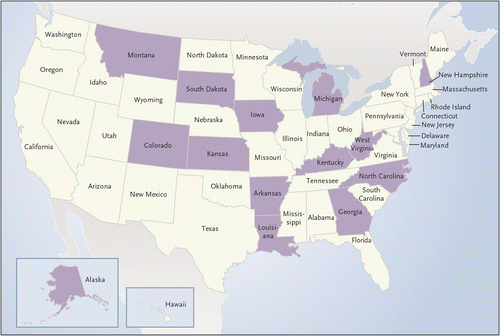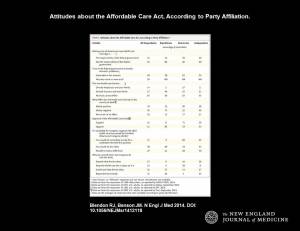 In the November 2014 mid-term elections, Democrats tend to favor continuing the Affordable Care Act (ACA) as-is, and Republicans favor scrapping it, scaling it back, or fully replacing the law with something yet to be defined. But it’s hard to read just where the ACA will end up after tomorrow’s election, because many key battleground states are too close to call…and the two major parties have such polar views on health reform.
In the November 2014 mid-term elections, Democrats tend to favor continuing the Affordable Care Act (ACA) as-is, and Republicans favor scrapping it, scaling it back, or fully replacing the law with something yet to be defined. But it’s hard to read just where the ACA will end up after tomorrow’s election, because many key battleground states are too close to call…and the two major parties have such polar views on health reform.
What’s most significant this year is that those most likely to vote are less likely to vote for a congressional candidate who supports the ACA (40%) than would vote for a candidate (31%). Only 1 in 4 people say a candidate’s stance on the ACA doesn’t matter.
Bob Blendon, the sage Harvard health pollster, published his analysis on Voters and the Affordable Care Act in the 2014 Election in last week’s New England Journal of Medicine. As usual, Professor Blendon, who leads the Harvard Opinion Research Program, and Managing Director of the Program, John Benson, provide a balanced view that weaves together the results of 27 major 2014 election polls taking in the past few weeks.
The map shades the 14 battleground states according to the Cook Political Report and Real Clear Politics. Those states are Alaska, Arkansas, Colorado, Georgia, Iowa, Kansas, Kentucky, Louisiana, Michigan, Montana, New Hampshire, North Carolina, South Dakota, and West Virginia.
Averaging poll results, Blendon and Benson find that national support for the ACA has eroded since its enactment in 2010, with 45% opposing the ACA when enacted in 2010, and 51% opposing the ACA in 2014. Disapproval of President Obama’s handling of health care has also grown from 52% disapproval in 2010 to 57% of people disapproving in 2014.
The authors point out that this disapproval grew even though millions of uninsured people gained insurance in the past four years, health insurance security has improved, Medicaid expanded, and people have received subsidies to purchase insurance and receive preventive care “for free” as provided by the ACA. Blendon and Benson say that since most Americans don’t believe they’ve been directly impacted by the law, a plurality of people say it has had a mostly negative effect on the nation.
 They also point out a decline in public trust in the federal government to handle domestic problems, falling from 51% in 2012 to 40% in 2014, which may be playing a factor in the decline of ACA sentiment. And, the authors also point to the “extraordinary level” of paid negative advertising opposing the ACA that has been broadcasted since the ACA’s enactment in 2010. $445 million has been spent for ads related to the ACA through the start of 2014, with a bulk of ads placed during this 2014 campaign season.
They also point out a decline in public trust in the federal government to handle domestic problems, falling from 51% in 2012 to 40% in 2014, which may be playing a factor in the decline of ACA sentiment. And, the authors also point to the “extraordinary level” of paid negative advertising opposing the ACA that has been broadcasted since the ACA’s enactment in 2010. $445 million has been spent for ads related to the ACA through the start of 2014, with a bulk of ads placed during this 2014 campaign season.
The second chart shows the party polarity regarding health care issues, from very different feelings about universal care coverage (with 70% of Democrats saying it’s the federal government’s responsibility, versus 12% of Republicans) to trust in government to handle domestic problems (with 63% of Democrats having a great deal or fair amount of trust versus 28% of Republicans).
Support for the ACA had 71% of Democrats versus 11% of Republicans, averaging out at 41% of the public.
Health Populi’s Hot Points: Even in the midst of this politically murky forecast, most voters do not support repealing the ACA. That is the case even with the $445 million spent on anti-ACA advertising over the past four years since the enactment of the ACA.
The outcome of this mid-term election will probably impact health care and, especially, the ACA. Republican majorities could move the needle toward scaling back the ACA, with Democrats favoring continued expansion and moving ahead with the law.
What’s quite possible with Republican majorities is their cutting budgets for health insurance subsidies, expansion of Medicaid, public health grants, and outreach support (via health insurance navigators and other channels).
What’s certain, Blendon and Benson conclude, is that deep divisions between the parties mean continued conflicts over health care policy. This makes our jobs as health care planners, marketers, product developers, and researchers all the more needing scenario planning and robust strategies that play well across many alternative health care futures.




 I'm in amazing company here with other #digitalhealth innovators, thinkers and doers. Thank you to Cristian Cortez Fernandez and Zallud for this recognition; I'm grateful.
I'm in amazing company here with other #digitalhealth innovators, thinkers and doers. Thank you to Cristian Cortez Fernandez and Zallud for this recognition; I'm grateful. Jane was named as a member of the AHIP 2024 Advisory Board, joining some valued colleagues to prepare for the challenges and opportunities facing health plans, systems, and other industry stakeholders.
Jane was named as a member of the AHIP 2024 Advisory Board, joining some valued colleagues to prepare for the challenges and opportunities facing health plans, systems, and other industry stakeholders.  Join Jane at AHIP's annual meeting in Las Vegas: I'll be speaking, moderating a panel, and providing thought leadership on health consumers and bolstering equity, empowerment, and self-care.
Join Jane at AHIP's annual meeting in Las Vegas: I'll be speaking, moderating a panel, and providing thought leadership on health consumers and bolstering equity, empowerment, and self-care.